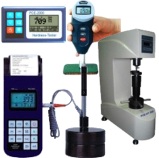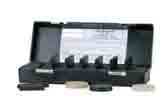
|
|||||||||||
|
Durometers |
|||||||||||
|
|||||||||||
|
Here you can see durometers from this company:
|
|||||||||||
| Technical specifications for a durometer can be found at the following links: | |||||||||||
|
- PCE-DX-A (Shore A) Durometers
|
 |
||||||||||
|
- PCE-DX-AS (Shore A) Durometers |
 |
||||||||||
|
- HB series Durometers |
|||||||||||
|
- PCE-DX-DS (Shore D) Durometers |
|||||||||||
|
- PCE-A (Shore A) Durometers |
|||||||||||
|
- PCE-D (Shore D) Durometers |
|||||||||||
|
- PCE-O (Shore O) Durometers |
|||||||||||
|
- PCE-OO (Shore O) Durometers |
 |
||||||||||
|
- PCE-AL (Shore A) / PCE-DL (Shore D) Durometers |
 |
||||||||||
|
- PCE-DD A (Shore A) Durometers |
 |
||||||||||
|
- PCE-DD D (Shore D) Durometers |
 |
||||||||||
|
- PCE-2500 Durometers |
 |
||||||||||
| - PCE-1000 Durometers (Accurate pocket-sized durometers with a wide measurement range) |
 |
||||||||||
|
- PCE-2000 Durometers |
|||||||||||
|
- HN-D
Durometers |
 |
||||||||||
|
- HM-P Durometers |
|||||||||||
| - PCE-2800 Durometers (Portable hardness tester for metallic materials with printer, memory and software) |
 |
||||||||||
|
- HM-M Durometers |
 |
||||||||||
|
- HK-D Durometers |
 |
||||||||||
|
- HM-O Durometers |
 |
||||||||||
|
- HM-R Durometers |
 |
||||||||||
|
Procedures of Hardness Testing Procedures for hardness testing are divided into static and dynamic ones. All are based on the same principle: A penetration device is pushed into the material with constant and certain test load. After that, the local deformation is measured. Depending on the size of the test load, it is distinguished between: Macro- (test load F > 30 N), small load- (2-30 N) and micro hardness (< 0,5 N). The procedures for hardness testing after Brinell, Vikkers or Rockwell belong to the static testing procedures. In the dynamic procedures (Shore hardness- or Pendulmhammer-method as well as manual hardness testing methods) the penetration device is pushed into the material from a certain distance with the help of kinetic energy. Pipes, turbine shafts and forgings are tested with these methods. DIN 50150 tablets are available for the comparison of values which come from different procedures. Information on hardness testing procedures, our durometer uses: The Leeb hardness is defined by the relation of rebound speed of a smashing object to its impact speed, multiplied with 1000. The harder a material surface is, the higher is its rebound speed. For specific groups of material (steel, aluminumů) the Leeb hardness establishes a direct relation to its hardness properties. For normal metals, curves for converting of hardness HL to other static standard hardnesses (HB, HV, HRC etc.) are deposited in this hardness meter and make it possible to convert Leeb hardness into other hardness values and display them. In conclusion, the durometer is a device for technicians (input and output control, production, development and research). Brinell: The hardness testing procedure developed by Brinell is used for the testing of soft and semi-hard metals, unalloyed steel or aluminum alloys, for wood and materials with irregular structure (for example cast iron). In this process, a steel ball or a carbide ball with a determined test force is pushed into the material. Shore: The Shore hardness is a material parameter for elastomers and plastics and is at DIN 53505 and DIN 7868. The shore-hardness testing for rubber or similar material consists of a spring loaded pin whose elasticity (when entering the material) is an indicator for the shore-hardness of the material which is displayed on a scale from 0 (2,5 mm penetration depth) up to 100 shore (0 mm penetration depth). Rockwell: The Rockwell hardness HRC of a material results from the norm DIN EN ISO 6508 from the penetration depth of a conical diamond. With the help of a specified test load, this cone with a sharpening angle of 120° is pressed into the work piece. The penetrated depth of the indenter serves as a reference. After that, the indenter is loaded with the brunt and hold for maximal 6 seconds. Afterwards, the brunt is removed again. Only the preload is effective now. The difference of the depths before and after laying on the brunt is the degree for the Rockwell hardness of the material. You can find a durometer for each of the listed hardness testing procedures. Optionally, the devices can also be calibrated according to ISO or DKD. A continuously reliable measurement is guaranteed thanks to hardness meters. Vickers: In contrast to the Rockwell testing procedure, a pyramidal diamond with an opening angle of 136 degrees is pressed into the surface of the work piece. You will find a variety of accessories, test equipment and adaptors, available on the web. Call us if you have any questions regarding our durometers: If you wish to view or print a selection of durometers from our catalogue, click the PDF symbol. |
|||||||||||
|
You are currently at: Home / measuring instruments and test equipment / Durometers |
|
If you have any questions, call our offices on: |
|
This page in German |











